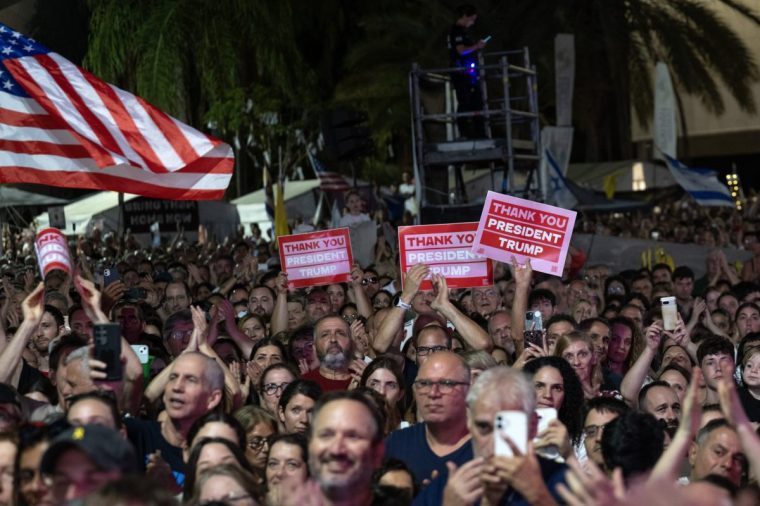Most of Trump’s predecessors would have likely waited before getting on a place to Tel Aviv
There is nothing President Donald Trump likes more than a victory lap. And in the realm of US foreign policy, his hastily arranged trip to the Middle East this week is designed to present him with the backdrop for a victory lap like no other.
The White House offered very few early details of the President’s plans for Monday, when he is set to arrive in Tel Aviv. Late on Saturday, reporters were simply told that Trump was arriving in Israel in time for Monday’s planned release of around 20 living Israeli hostages, who were spending what may prove to be their final hours in Hamas captivity.
Trump’s enthusiasm to strike a deal that may end the war in Gaza was fuelled in part by families rallying in Tel Aviv’s “Hostages Square” over the last few months, many carrying signs with his image and urging his personal intervention to bring their misery to an end.
“They have my name up. They like me”, Trump said last month during Israeli Prime Minister Benjamin Netanyahu’s visit to the White House. “They say two things: ‘please get the hostages back’ and ‘please end the war’. They’ve had it”, the President told reporters.
On Saturday, Trump’s son-in-law Jared Kushner and special envoy Steve Witkoff personally took to the stage in the square to celebrate the agreement they helped broker between Israel and Hamas.
Witkoff told the crowd he had “dreamed of this moment”, and said “I only wish the President was here. He would love this”. Hostage families and their supporters offered loud cheers, while there were also hostile boos when Witkoff paid tribute to Netanyahu’s role in the negotiations.

Even so, Trump’s trip to Tel Aviv is not without substantial risk. Most of his predecessors would almost certainly have waited to ensure that the agreement brokered last week in the Egyptian Red Sea resort city of Sharm El-Sheikh actually comes into force as planned, before boarding Air Force One and flying to the region.
The President’s determination to quickly celebrate the signature foreign policy moment of his second administration to date provides potential scope for Hamas to embarrass him on the world stage. Hostage families, angst-ridden in the hours leading up to their loved ones release, can only hope that Hamas goes ahead and frees them, and makes no effort to cause them any further harm.
Similarly, Trump will be aware that there are ongoing discussions about whether senior high-profile Palestinian detainees will be released by Israel as Hamas is demanding. Netanyahu is planning to return 250 Palestinian prisoners and 1,700 detainees from Gaza. But with negotiations continuing about the precise composition of those groups, that could also become a last-minute snag.
More worrying still are reports that thousands of Hamas fighters are mobilising across Gaza and taking control of areas where the Israel Defense Forces (IDF) has already withdrawn. Social media over the weekend included accounts of alleged Israeli collaborators among the civilian population being knee-capped or detained by armed Hamas fighters who show no sign of agreeing to demilitarise. Security in Gaza after any hostage release occurs could still prove to be the agreement’s undoing.
Humanitarian aid convoys, so urgently needed by the civilian population, are beginning to secure access to Gaza. Israel has reportedly agreed to 400 truckloads of assistance entering the territory every day.
Distribution of that aid will be a vastly complex operation. In recent months, scores of Palestinian civilians have been killed in stampedes for assistance, or by the IDF during botched efforts by the Gaza Humanitarian Foundation – a joint US/Israeli operation – to deliver piecemeal amounts of aid to the Strip.
If all goes well, on Monday Trump will address Israel’s Knesset and receive a hero’s welcome. He is also expected to meet hostage families.
After months of tolerating Netanyahu’s ongoing war on Gaza, Trump forced the prime minister to sue for peace after Israel’s disastrous 9 September attack on members of a Hamas negotiating team in Qatar, a steadfast US ally. There will now be great interest in how he defines the next stage of the process in Gaza, and whether he delivers any kind of long-term vision for the territory.
Asked at the White House last week whether he supported a two-state solution in the region, Trump said, “I don’t have a view. I’m going to go with what they agree to”.
Right now, Trump has to hope the next few hours pass off exactly as planned. Otherwise, his decision to travel to Israel in haste could leave him repenting at leisure.
